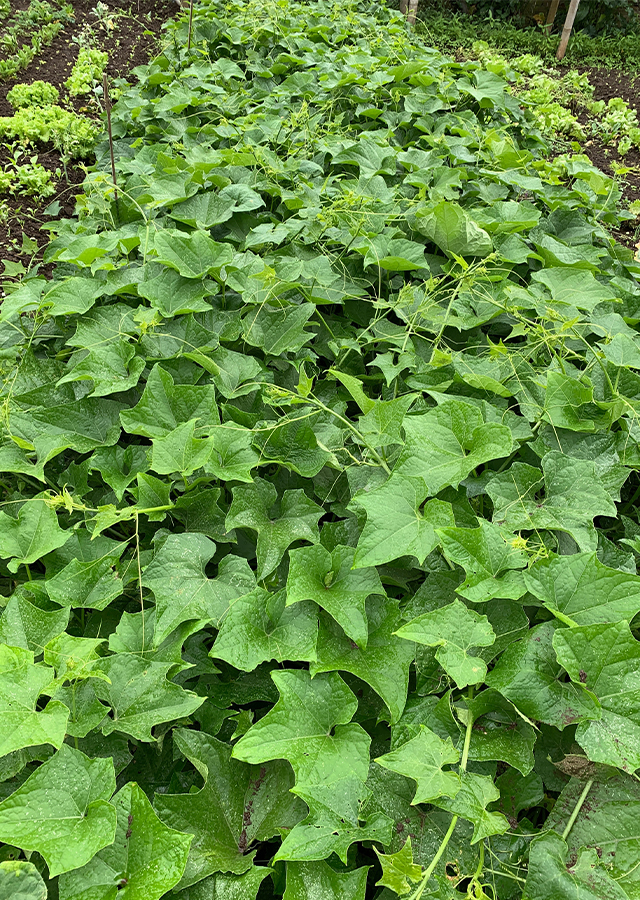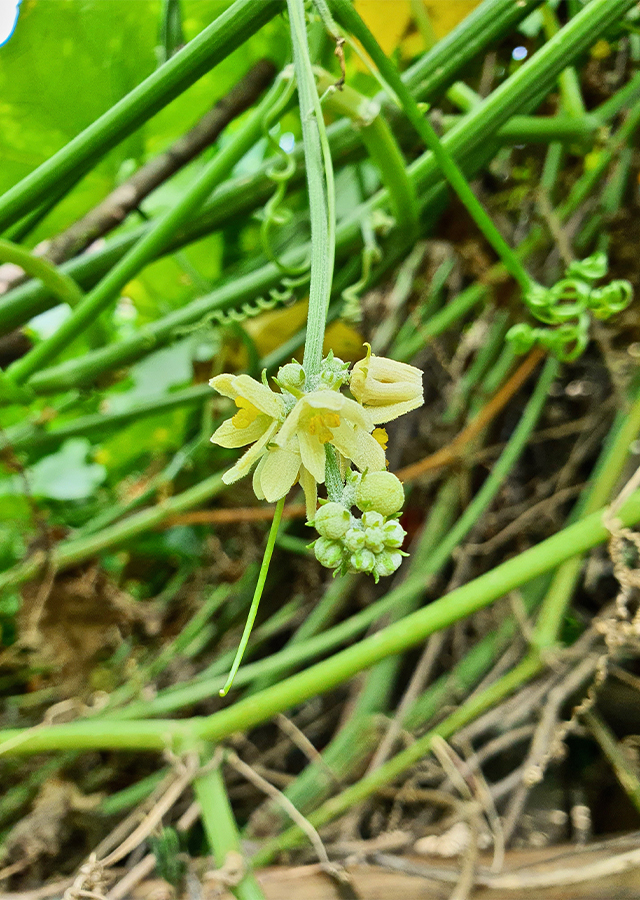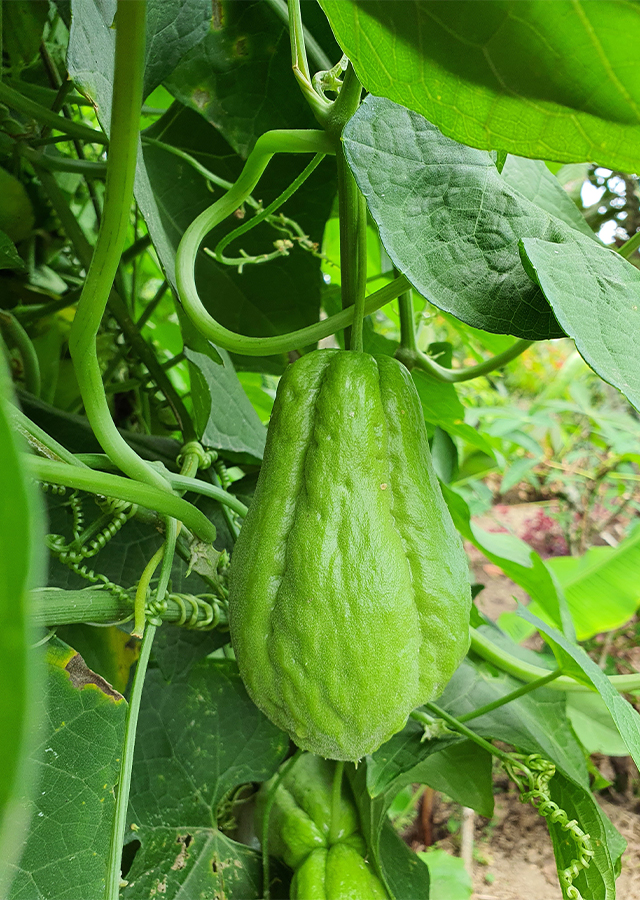Chayote
Sicyos edulis Jacq.
Cucurbitaceae
Location in our garden
Vegetable



Synonym
Chayota edulis (Jacq.) Jacq.
Sechium edule (Jacq.) Sw.
Sicyos laciniatus Descourt.
Habitus
Climbers. A monoecious, vigorous, perennial herbaceous climber, growing up to 30 m long
Part Used
Leaves
Fruit
Tuber
Growing Requirements
Full Sunshine
Need Shade
Habitat
Riverbanks
Forest
Grassland
Overview
Chayote is found wild in the cool mountains of Central America where it was first domesticated by the Aztecs. It has become a very popular food in many parts of the tropics and subtropics, where it is widely cultivated, and also supplies medicines and is a source of fibre. Young leaves and stem tips, cooked as a vegetable, eaten like asparagus, is a good source of iron, carotene, thiamine, riboflavin and niacin.
Vernacular Names
Chun jen kua (Chinese), Groente peer (Dutch), Christofine (French), Quash (India), Zucca (Italian), Hayatouri (Japanese), Sayote (Philippines), labu siam (Indonesia), choko (Papua New Guinea), susuu (Cambodia), ma-kheua-kreua (Thailand), taeng-kariang (Vietnam).
Agroecology
Chayote requires high relative humidity (80-85%), annual rainfall of at least 1500-2000 mm (or irrigation) and average temperatures of 20-25 °C (with limits of 12-28 °C). It grows best at 300-2000 m altitude. It is susceptible to frost, drought and wind. The natural habitats of wild chayote are moist steep hillsides. The plant generally grows well in full sun, but some cultivars produce higher yields when grown in light shade. It grows best in a sheltered position in a well-drained, fertile, humus-rich soil. Prefers a pH in the range 5.5 - 7, tolerating 4.3 - 8.
Morphology
- Stems- tuberous, climbing or sprawling, tendrils large, 2-5-branched.
- Leaves - hairy, broadly cordate, entire or angled, 10 to 20 cm long. Leaf petioles are 6 inches long.
- Flowers - staminate, yellowish to pale green, in long racemes. Pistillate flowers are solitary, corolla 12 to 17 mm.
- Fruits - pear-shaped, green, and slightly wrinkled or with shallow, narrow, longitudinal grooves, in some forms set with soft spines.
- Seeds - single, large, with a smooth testa, clinging to the flesh, protruding from the fruit apex.
Cultivation
Propagated by seeds and stem cuttings.
Chemical Constituents
Flavonoids, phenolic, carotenoid, tannins, alkaloids, sterols, saponins, triterpenes, fatty acids, cinnamic acid.
Traditional Medicinal Uses
- Fruit is laxative.
- The leaves and fruit have anti-inflammatory properties, diuretic, laxative, cardiovascular modifying as well as blood pressure lowering properties and to dissolve kidney stones.
- The tubers are a potent diuretic and are also applied for pulmonary ailments and relief of intestinal inflammation.
- The raw pulp of the fruit is soothing for skin rashes and roasted leaves used in the suppuration of boils.
- An infusion of the shredded fruit is used to lower blood pressure.
- Decoction of leaves is drunk to relieve urinary retention and dysuria (burning when urinating) and to dissolve kidney stones.
- Juice from the leaves used for the treatment of various kind of liver disorder.
Part Used
Reference Sources
- CABI. (2018). Invasive Species Compendium. Sechium edule(chayote). https://www.cabi.org/isc/datasheet/49493. 08-02-2021.
- Engels, J.M.M. (2004). Pl@nt Use. Sechium edule (PROTA). https://uses.plantnet-project.org/en/Sechium_edule_(PROTA) 20-07-2020
- Fern, Ken. (2014). Useful Tropical Plants. Sechium edule. http://tropical.theferns.info/viewtropical.php?id=Sechium+edule. 08-02-2021.
- Lim, T.K. (2012). Edible Medicinal And Non-Medicinal Plants: Vol. 2, Fruits. Springer. DOI 10.1007/978-94-007-1764-0_1 (pp.384-391).
- Research gate. (2016). Pharmacognostical and Preliminary Phytochemical Screening of Roots of Sechium edule (Jacq.) Sw. https://www.researchgate.net/publication/341432142_Pharmacognostical_and_Preliminary_Phytochemical_Screening_of_Roots_of_Sechium_edule_Jacq_Sw 08-02-2021
- StuartXchange. (2016). Philippines Medicinal Plants. Sayote. http://www.stuartxchange.com/Sayote.html . 08-02-2021.
- RBGKEW. (2021). Sicyos edulis Jacq. http://www.plantsoftheworldonline.org/taxon/urn:lsid:ipni.org:names:293946-1
- Engels, J.M.M & C. Jeffrey, C. (1994). Sechium edule (Jacq.) Swartz. In: Siemonsma, J.S. and Piluek, K. (F.ditors): Plant Resources of South-East Asia No 8. Vegetables. Prosea Foundation, Bogor, Indonesia. pp. 246-248


